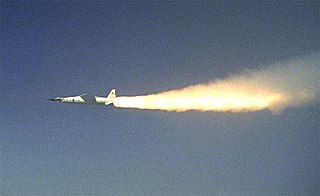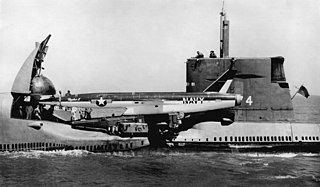
A ramjet, is a form of airbreathing jet engine that uses the forward motion of the engine to take in air for combustion that produces jet thrust. Since it produces no thrust when stationary ramjet-powered vehicles require an assisted take-off like a rocket assist to accelerate it to a speed where it begins to produce thrust. Ramjets work most efficiently at supersonic speeds around Mach 3 and can operate up to speeds of Mach 6.
The SM-65 Atlas was the first operational intercontinental ballistic missile (ICBM) developed by the United States and the first member of the Atlas rocket family. It was built for the U.S. Air Force by the Convair Division of General Dynamics at an assembly plant located in Kearny Mesa, San Diego.

A scramjet is a variant of a ramjet airbreathing jet engine in which combustion takes place in supersonic airflow. As in ramjets, a scramjet relies on high vehicle speed to compress the incoming air forcefully before combustion, but whereas a ramjet decelerates the air to subsonic velocities before combustion using shock cones, a scramjet has no shock cone and slows the airflow using shockwaves produced by its ignition source in place of a shock cone. This allows the scramjet to operate efficiently at extremely high speeds.

The NASA X-43 was an experimental unmanned hypersonic aircraft with multiple planned scale variations meant to test various aspects of hypersonic flight. It was part of the X-plane series and specifically of NASA's Hyper-X program developed in the late 1990s. It set several airspeed records for jet aircraft. The X-43 is the fastest jet-powered aircraft on record at approximately Mach 9.6.

The North American SM-64 Navaho was a supersonic intercontinental cruise missile project built by North American Aviation (NAA). The final design was capable of delivering a nuclear weapon to the USSR from bases within the US, while cruising at Mach 3 at 60,000 feet (18,000 m) altitude. The missile is named after the Navajo Nation.
Scramjet programs refers to research and testing programs for the development of supersonic combustion ramjets, known as scramjets. This list provides a short overview of national and international collaborations, and civilian and military programs. The USA, Russia, India, and China (2014), have succeeded at developing scramjet technologies.

Operation Bumblebee was a US Navy effort to develop surface-to-air missiles (SAMs) to provide a mid-range layer of anti-aircraft defense between anti-aircraft guns in the short range and fighter aircraft operating at long range. A major reason for the Bumblebee efforts was the need to engage bombers before they could launch standoff anti-shipping weapons, as these aircraft might never enter the range of the shipboard guns.

The Gorgon missile family was a series of experimental air-to-air, air-to-surface, and surface-to-surface missiles developed by the United States Navy's Naval Aircraft Modification Unit between 1943 and 1953. The immaturity of the technology involved meant that none of the Gorgon missiles achieved operational service, however they were extensively used in the development of guided missile controls and guidance technologies.

The MA-31 was a conversion of the Kh-31, an anti-ship missile developed by the Soviet Union during the 1980s, for use as a target drone by the United States Navy. Although the missile proved successful in this role, political complications resulted in the type being only an interim solution, and only a small number of the missiles were acquired.

The MQM-42 was a supersonic target drone developed by North American Aviation. Developed in two subvariants, Redhead and Roadrunner, it was used by the United States Army in the 1960s and 1970s.

The SSM-N-9 Regulus II cruise missile is a supersonic guided missile armed with a nuclear warhead, intended for launching from surface ships and submarines of the U.S. Navy (USN).

The Advanced Strategic Air-Launched Missile (ASALM) was a medium-range strategic missile program, developed in the late 1970s for the United States Air Force. Intended for use in both the air-to-surface and anti-AWACS roles, the missile's development reached the stage of propulsion-system tests before being cancelled in 1980.

The AQM-127 Supersonic Low-Altitude Target (SLAT) was a target drone developed during the 1980s by Martin Marietta for use by the United States Navy. Derived from Martin Marietta's work on the cancelled ASALM missile, SLAT proved to have severe difficulties in flight testing, and the project was cancelled during 1991.
The ASM-N-5 Gorgon V was an unpowered air-to-surface missile, developed by the Glenn L. Martin Company during the early 1950s for use by the United States Navy as a chemical weapon delivery vehicle. Developed from the earlier PTV-N-2 Gorgon IV test vehicle, the program was cancelled without any Gorgon Vs seeing service.

The AAM-N-4 Oriole was an early American air-to-air missile, developed by the Glenn L. Martin Company for the United States Navy. Designed for launch from carrier-based aircraft, the missile programme was cancelled before flight testing began, and the missiles produced were utilized as test vehicles.

The AAM-N-5 Meteor was an early American air-to-air missile, developed by the Massachusetts Institute of Technology and Bell Aircraft for the United States Navy. Initially, both air-launched and ship-launched versions were considered. Versions designed for launch from carrier-based aircraft proceeded to the flight testing stage before the project was cancelled.

The LTV-N-4 was an American experimental rocket, developed by the Naval Ordnance Test Station for the development and testing of large solid-fueled rocket boosters for ramjet-powered missiles. Described as "more powerful than the V-2", a number of test flights were conducted during 1949.

The Radioplane XKD4R, known by the company designation RP-70, was an American target drone developed by the Radioplane Division of the Northrop Corporation. Although it was not produced in quantity, it was developed into the successful AQM-38.

The PTV-N-2 Gorgon IV was a subsonic ramjet-powered missile developed by the Glenn L. Martin Company for the United States Navy. Originally intended as an air-to-surface weapon, it materialized as a propulsion test vehicle, and between 1947 and 1950 was used for test purposes and, as the KDM Plover, as a target drone.

Solid Fuel Ducted Ramjet (SFDR) is a missile propulsion system currently being developed by the Defence Research and Development Organisation of India. The project aims to develop critical technologies required in the propulsion systems of future Indian long range air-to-air missiles.



















